
Полная версия:
Madeira


In the Gardens
Queensland Kauri
Agathis robusta
Bloom time
March.
Characteristics
The tree reaches a height of 10-20 m (11-22 yd.). Its crown is larger in height than in width. The tough leaves are slender and tapered and stick rigidly out from the twigs. The female blooms are light brown, longish and slightly curved cones that are shorter than the leaves. They disintegrate at maturity of the fruits.
Site:
The Queensland Kauri requires sunlight and warmth, thus you will mainly find it close to the southern coastal line. It barely grows in regions higher than 100 m (110 yd.) above sea level. It is frequently found in the parks and hotel gardens of Funchal and lines roads in the city centre; e.g. the Avenida do Mar or the Avenida do Infante.
Interesting to know:
The tree is native to Northeast Australia. Although seeming to resemble a deciduous tree, Queensland Kauri is a conifer and part of the Araucaria family. The natural habitats of the Araucariaceae can all be found on the southern hemisphere. Two species related to Queensland Kauri, the Borneo Kauri (Agathis dammara), native to the Philippines, and the New Zealand Kauri (Agathis australis), native to New Zealand, are providing wood and kauri resin. The amber-coloured, hard resin is for example used to produce varnishes.
16
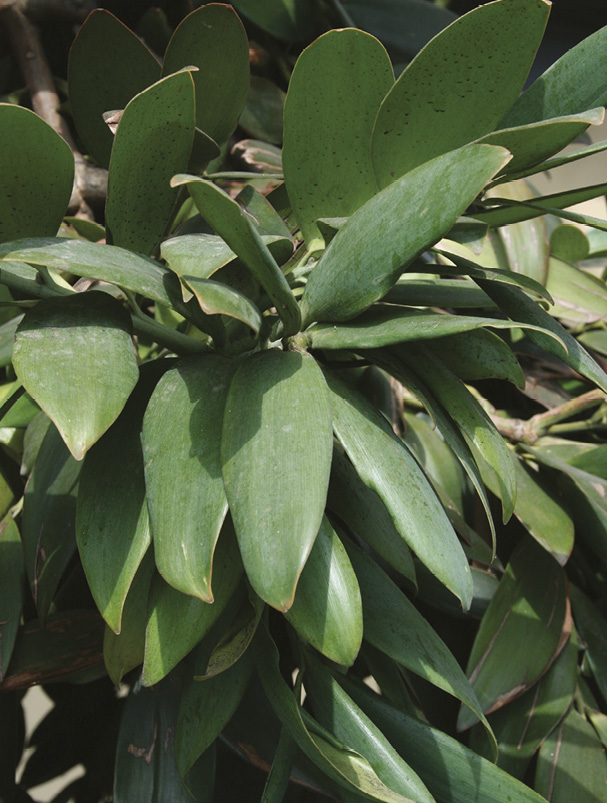
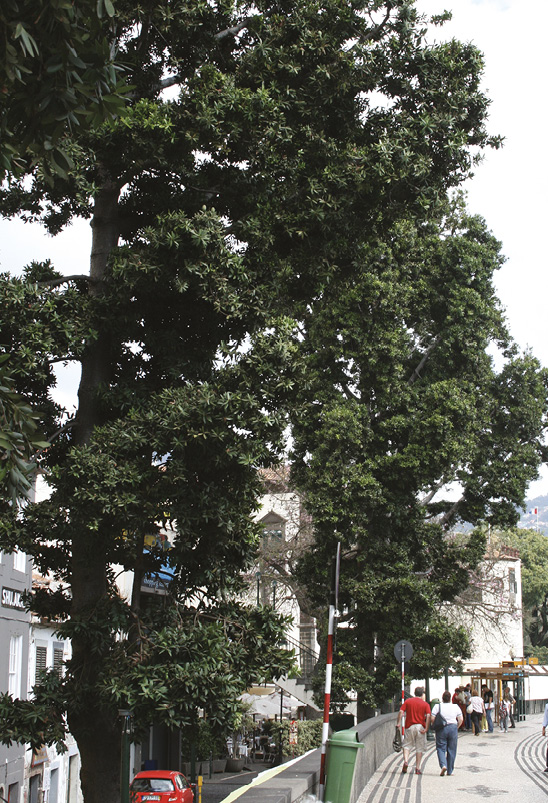


In the Gardens
Weeping Fig
Ficus benjamina
Bloom time
All around the year.
Characteristics
The giant tree that may grow up to 20 m (22 yd.) tall can develop various trunks and spreading branches with aerial roots. The oval, tapered leaves are quite small and similar to amber leaves but dispose of a milky sap. The inconspicuous blooms develop fig-like, red fruits (Ø 1 cm (0,4‘‘)).
Site:
You will find the Weeping Fig in parks up to an altitude of 200 m (220 yd.) above sea lev-el. Either as a single tree or in groups it may decorate a square and provide shade simulta-neously (e.g. at Largo dos Milagres in Machico, at the viewpoint in Rua das Cruzes, close to the Quinta das Cruzes (Funchal)). It may also line avenues like the Avenida do Mar, Funchal.
Interesting to know:
The Weeping Fig is native to Malaysia; anyway it is cultivated today in many tropical and sub-tropical countries. Younger specimens are used as indoor trees in many Central European hous-es. It is closely related to the Indian Rubber Tree (Ficus elastica). The Common Fig Tree (Ficus carica), native to the Mediterranean region, is another representative of this species-rich ge-nus. Single specimens of the latter are cultivat-ed on Madeira as useful plants (mainly in the northeast close to Faial and São Roque do Faial).
17
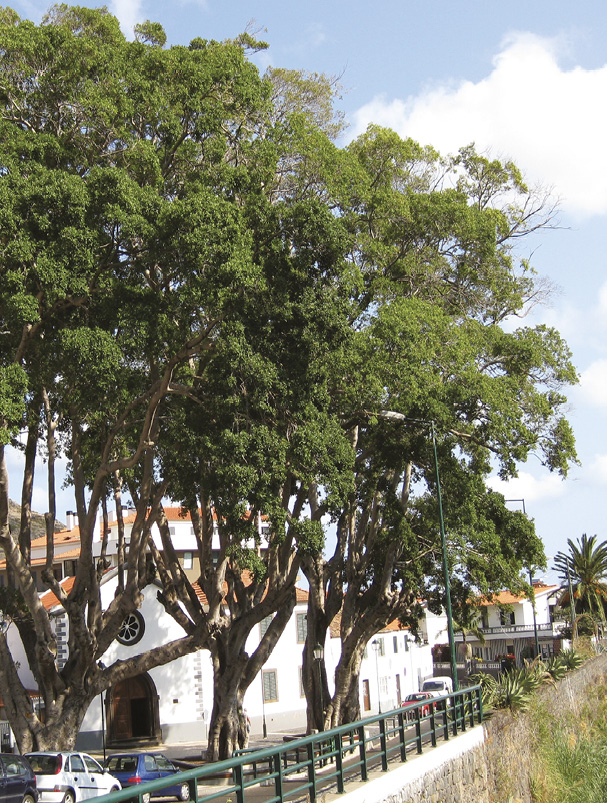
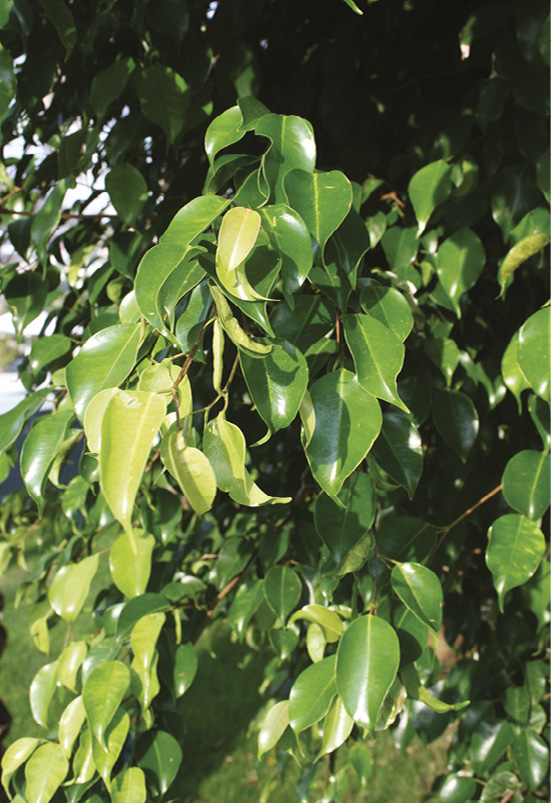


In the Gardens
Camphor Tree, Camphor Laurel
Cinnamonum camphora
Bloom time
From January to April.
Characteristics
The tree grows up to 20 m (22 yd.) high and disposes of a very close branch network. Together with its dense foliage this creates a spreading crown. The ovate, tapered leaves turn upwards remarkably feebly. The great number of inconspicuous, greenish blooms branches erectly from thin panicles.
Site:
The Camphor Tree is one of the most impress-ing trees that grows in Madeira’s parks. It prefers warm, sheltered sites close to the southern coast. You will mainly find it in Funchal, e.g. in the Parque Santa Catarina (198) or in the Quinta Magnólia (199).
Interesting to know:
The Camphor Tree is indigenous to China, Taiwan and Japan where it is admired for its giant stature and for being able to become hundreds of years old. Today it is recognized as an ornamental tree in all warm countries. The Camphor Tree resembles laurels and is assigned to the same family. Being crumbled, the leaves smell of camphor. Initially, cam-phor oil was produced by distilling it from the shavings. It has already been employed for centuries both externally against rheumatism and internally to support the heart functions.
18
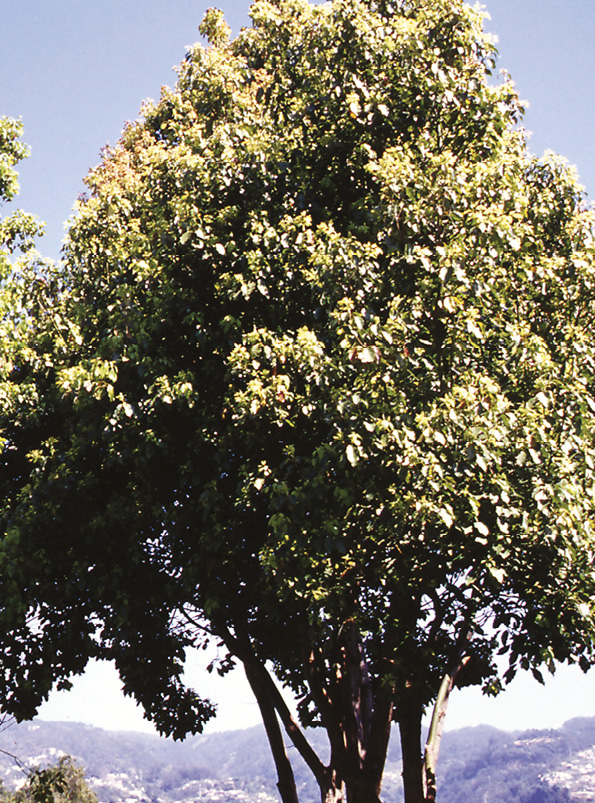
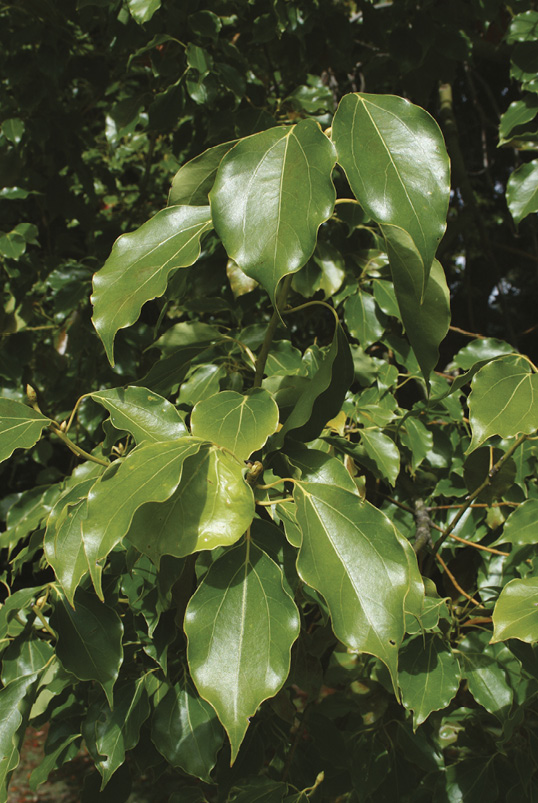


In the Gardens
Brazilian Kapok Tree,
Pink Floss Silk Tree
Ceiba speciosa
Bloom time
September and October
Characteristics
The trunk can grow up to 15 m (16 yd.) tall and tapers remarkably in upward direction. It is covered with conical spines. The hand-shaped leaves fall off in spring. The pear-shaped fruits contain a silky substance. The five-petaled, pink flowers develop before the new leaves emerge.
Site:
In the southern half of Madeira you will fre-quently find the Brazilian Kapok Tree up to an altitude of 350 m (385 yd.). It lines roads and decorates parks and gardens. Beautiful speci-mens can be contemplated e.g. in the Jardim Municipal (Funchal, 198) and in the garden of the Quinta Vigia (198). In Machico you will find a Kapok Tree next to the town hall, in Caniço at the Parking of Quinta Spléndida.
Interesting to know:
The Brazilian Kapok Tree is native to the savan-nahs of Brazil and Argentina. The fruits contain about 100 black seeds with white, woolly hairs that are distributed by wind. The Common Kapok Tree/Silk Cotton Tree (Ceiba pentandra) that does not grow on Madeira but is cultivat-ed on Asian plantations disposes of seed hairs that are of commercial value. They are waxy and do not absorb water - thus they are used to produce life jackets, lifebelts and mattresses.
19
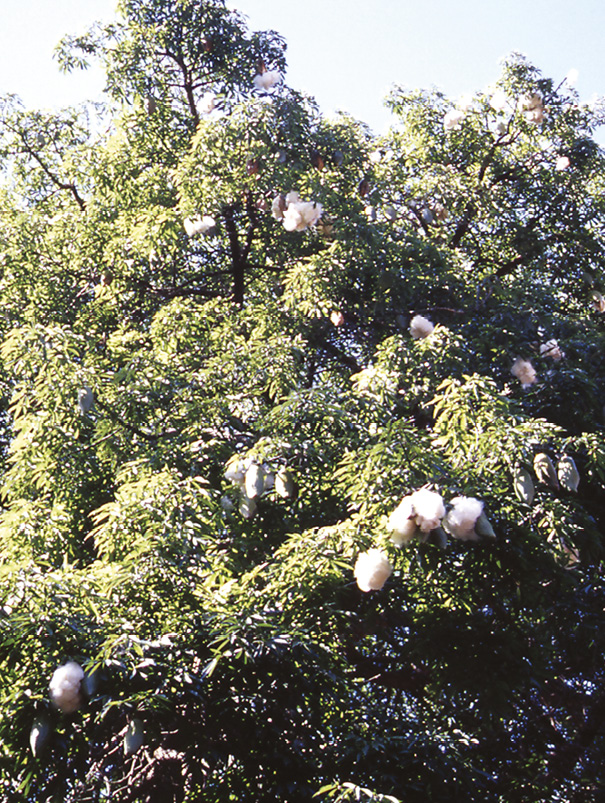
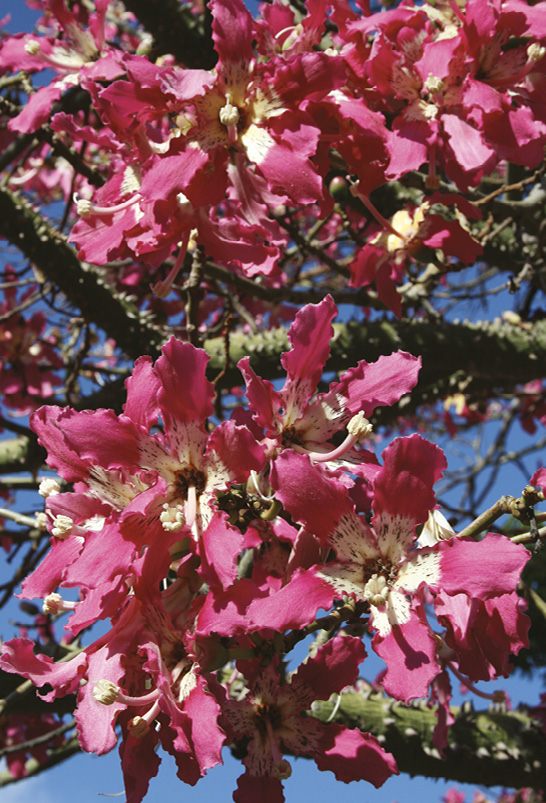


In the Gardens
Sausage Tree, Fetish Tree
Kigelia africana
Bloom time
From June to August.
Characteristics
The colour of the trumpet-shaped blossoms ranges from deep red to purple. They hang in loose panicles on long stalks. The typical sausage-like fruits are developing from the blossoms. Some are longish, others bulbous. The leaves of this tree that reaches a height of 5 m (5,5 yd.) are pinnate and fall off in winter.
Site:
You will find the Sausage Tree growing only in the south up to an altitude of 100 m (110 yd.). It is hardly ever cultivated in gardens and parks. Three beautiful specimens are situated in the Jardim Municipal in Funchal (198), another one in the Parque Santa Catarina (198). Two other specimens are to be found in the Quinta Magnólia (199).
Interesting to know:
The Sausage Tree is indigenous to West Africa. In this humid and warm regions it grows up to 20 m (22 yd.); the fruits may be up to 1 m (3,3‘) long and weigh up to 10 kg. The specimens that grow in Madeira’s gardens do not reach these dimen-sions. The fleshy fruits are inedible; anyway they are used in Africa by traditional medicine and magic. They are supposed to cure rheumatism, snake bits and syphilis as well as to protect from evil ghosts. The flowers only blossom one night. At daytime you only see buds or wilted blooms.
20
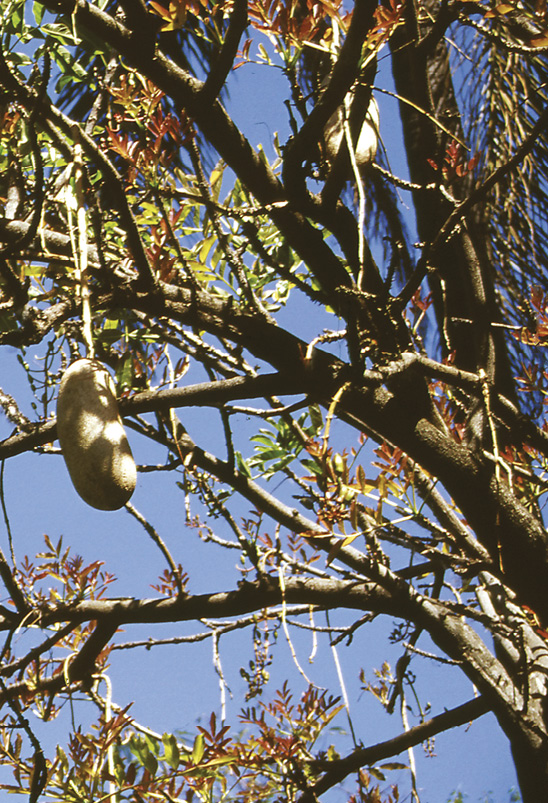
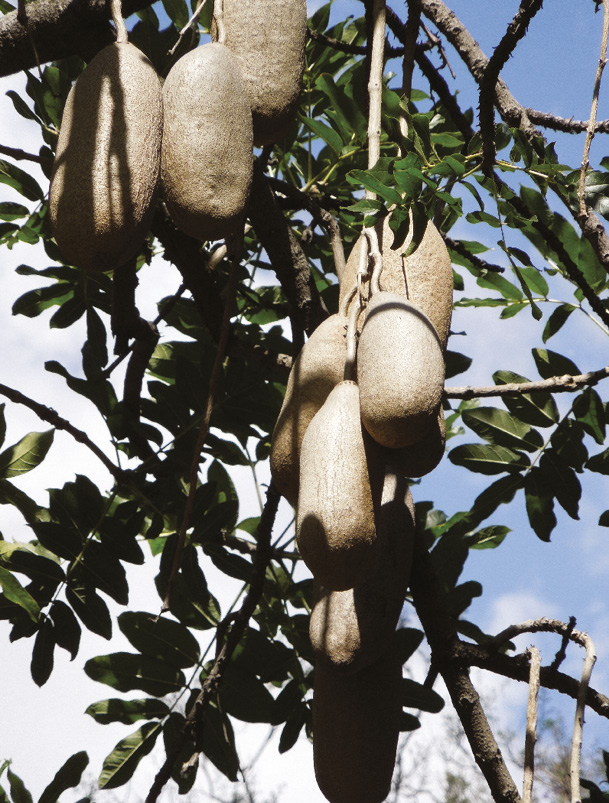


In the Gardens
African Tulip Tree,
Flame of the Forest
Spathodea campanulata
Bloom time
All year round.
Characteristics
The decorative tree can reach a height up to 25 m (28 yd.). Its dark green leaves are pinnate. Round inflorescences are situated on the surface of the dense, spherical crown. The tulip-like flowers are coloured from orange to scarlet and are slightly curved towards the centre of the blossom cluster.
Site:
In the southern coastal area of Madeira you will frequently find the tree as an ornamen-tal plant up to an altitude of 200 m (220 yd.). It lines town roads and grows in gardens and parks. In Funchal you find some speci-mens in the Parque Santa Catarina (198), in the Avenida do Infante and in the Avenida Luis Camões that leads towards the hospital.
Interesting to know:
The tree is native to the African savannahs where, in contrast to Madeira, it sheds its leaves in the arid season. Today it is one of the most popular ornamental plants in all countries that correspond to its climatic requirements. It is a fast growing tree; the wood is hardly usable. The outer buds bloom first while the inner, brown and hairy buds still remain closed. Birds in search of nectar will land on the latter ones. On Madeira, pollination is not taking place.
21
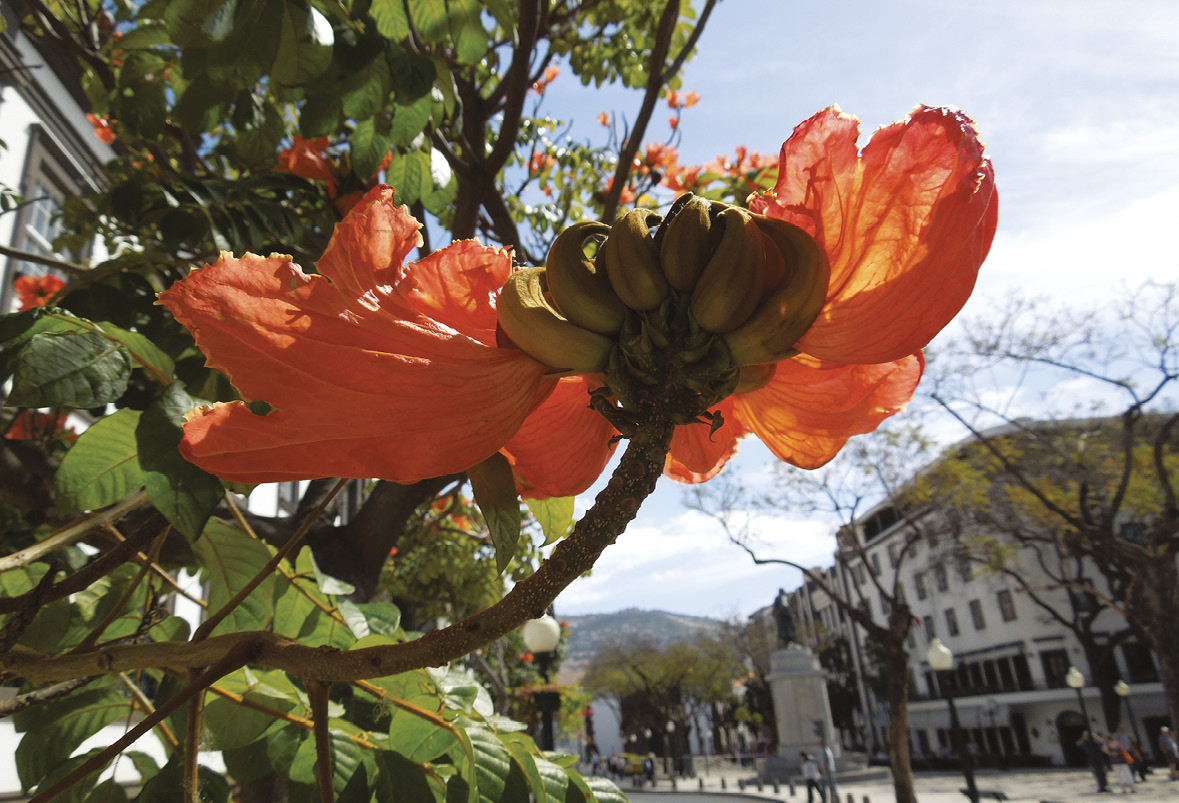


In the Gardens
Blue Jacaranda,
Brazilian Rosewood
Jacaranda mimosifolia
Bloom time
From April to May.
Characteristics
The gnarled growing tree grows up to 20 m (22 yd.) tall. In winter it sheds off its leaves. Before they sprout again in spring the bleak tree develops the popular blue-violet panicles of flowers. They consist of many single blossoms. As those of many fern species, the tender leaves are bipinnate.
Site:
In the south of Madeira the Blue Jacaranda is growing in gardens and parks up to an altitude of 300 m (330 yd.). In Funchal, Jacaranda is lining whole streets. There you may discover an especially conspicuous effect of the flowers at the end of April when they produce strongly violet shining avenues, e.g. in Avenida Arriaga, in Avenida do Infante or in Rua João de Deus.
Interesting to know:
The tree origins from the savannahs of South Brazil. The Portuguese explorers adapted the Indian name: the “j” at the beginning is pro-nounced like in journal, the emphasis is on the last syllable. Today Jacaranda is cultivated in many countries because of its spectacu-lar flowers. It is said that in Pretoria (South Africa) there are cultivated 6000 specimens.
22
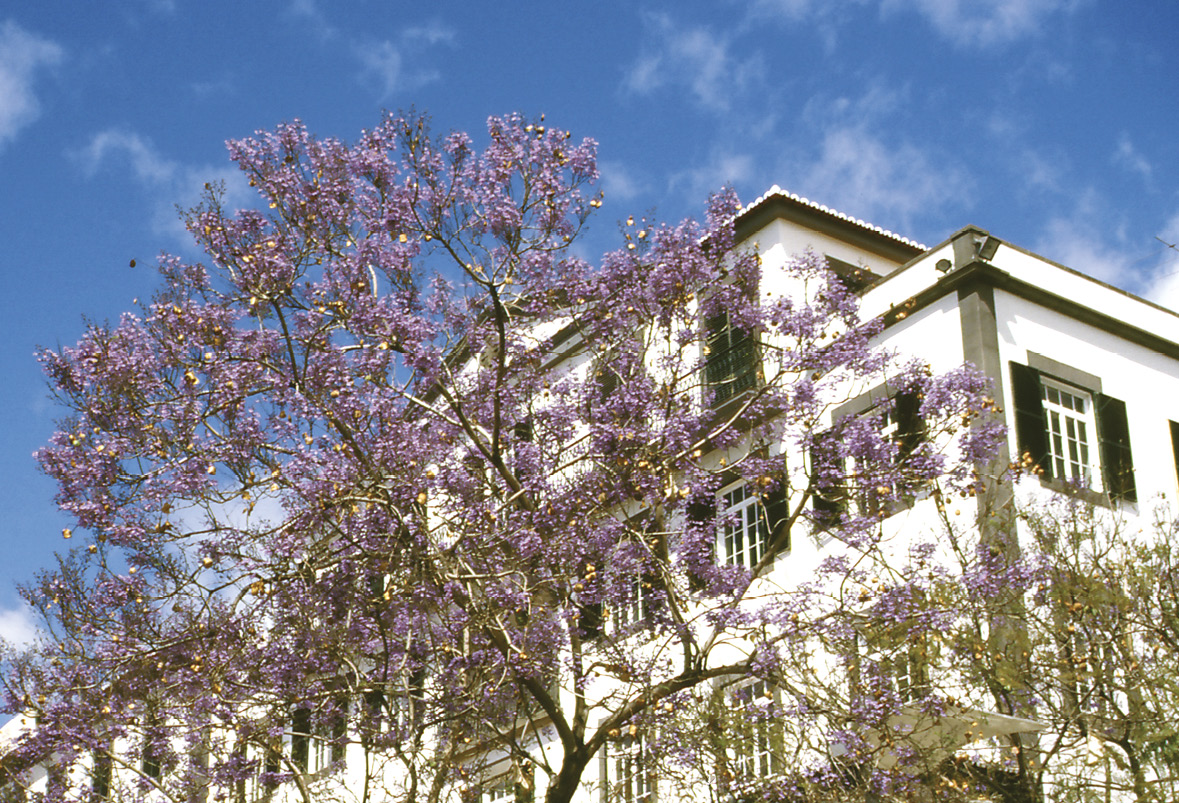


In the Gardens
Pride of Bolivia, Tipu Tree
Tipuana tipu
Bloom time
From June to September; dur-ing this time there are con-stantly emerging new blos-soms.
Characteristics
The imposing tree has dense foliage and a broad crown. It grows up to 10 m (11 yd.) tall. The long leaves are pinnate; the single com-pounds are longish and ovate. The yellow blossoms emerge from short panicles.
Site:
Although you may find the Pride of Bolivia on Madeira in regions up to an altitude of 600 m (655 yd.), it mainly grows in coastal areas. Especially in Funchal the tree is lin-ing many roads, e.g. the Avenida Zarco or the Rua Arcipreste behind the market hall.
Interesting to know:
The tree is native to South America (Brazil, Ar-gentina, Bolivia) where it can grow up to 35 m (38 yd.) tall. Its botanical denomination refers to the Valle Tipuana, a Bolivian valley in which the Tipu Tree develops larger populations. It belongs to the family of Fabaceae; thus it is not related to Jacaranda (Bignonia family, cf. p. 22). Anyway it is also called Yellow Jacaranda because of its pinnate leaves and blossom pan-icles. Pride of Bolivia is a fast growing, unde-manding and flexible tree, characteristics that make it popular as a street tree. Today it is even cultivated in mild regions of the Mediterranean.
23
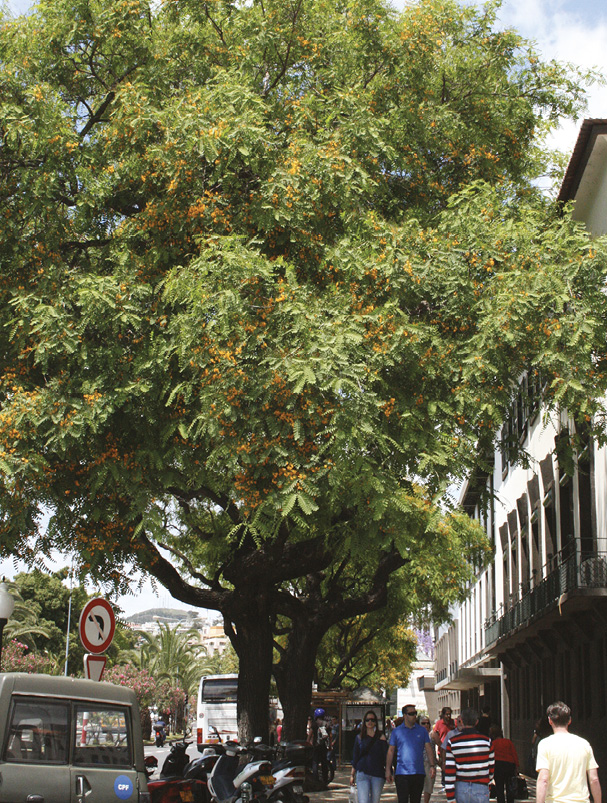
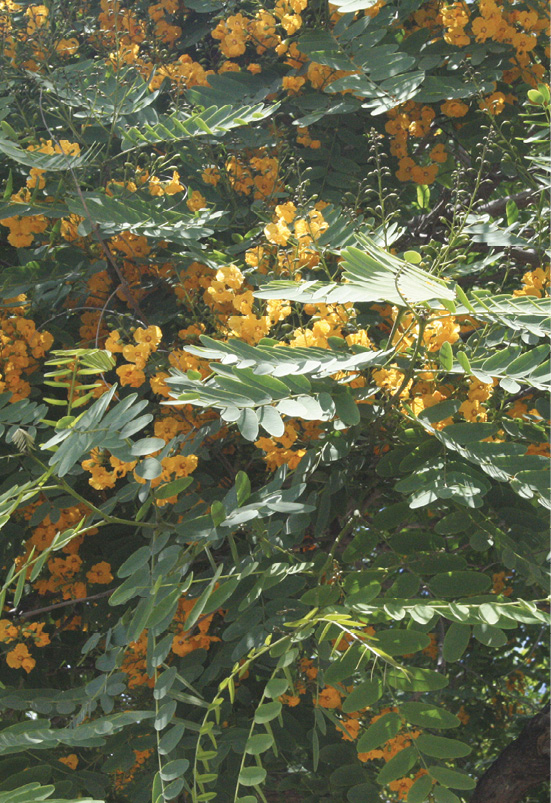


In the Gardens
Flame Tree
Brachychiton acerifolius
Bloom time
From April to September.
Characteristics
The Flame Tree grows up to 10 m (11 yd.) tall. The leaves consist of three to five lobes and are shed off in winter. In spring the plant develops the main blossoms before new leaves sprout. The scarlet blossoms are little and bell-shaped; they grow in long, hanging racemes.
Site:
At Madeira’s southern coast you will often find the Flame tree being cultivated as an ornamen-tal plant up to an altitude of 200 m (220 yd.). You may frequently see the plant in Funchal where it is both lining roads and growing in gardens and parks. An eye-catching specimen shades the inner courtyard of Funchal’s market hall.
Interesting to know:
The tree is native to Australia where it grows in the rainforest at the eastern coast. In South Africa you might see it frequently as a park tree. Its frost tolerance allows cultivating it even in the Mediterranean regions. The wood is extremely light and soft; thus you could hammer against the trunks of older speci-mens and will notice that they sound empty. The wood is sometimes employed to produce life belts; moreover it can serve as a substi-tute for balsa wood in model construction.
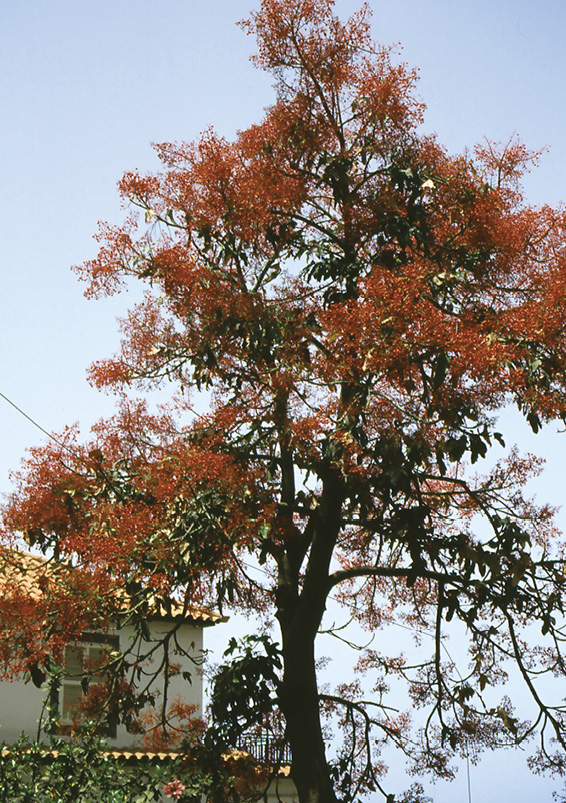

24


In the Gardens
Tropical Hydrangea Tree,
Pink Ball Dombeya
Dombeya wallichii
Bloom time
From November to February.
Characteristics
The tree grows spherical-ly and reaches up to 8 m (9 yd.) tall. It has dense foliage. The heart-shaped leaves are tapered, have a point-ed extreme and are tender-ly hairy on the underside. The hemispherical, hanging flowers remind of Hydran-geas. The single blossoms are pink with yellow stamens.
Site:
You will find the Hydrangea Tree in parks in the south, mainly in the region of Funchal and up to an altitude of 300 m (330 yd.). Specimen trees are growing in the Botani-cal Garden (190), in the Quinta das Cruzes (199) and in the Quinta Palmeira (195).
Interesting to know:
The tree is native to Madagascar. Today it is cul-tivated as an ornamental plant in all tropical countries. Despite of its name and the blossoms it is not related to Hydrangeas but belongs to the Mallow family (Malvaceae). The genus Dombeya got its name from J. Dombey (1742-1795), popu-lar as a traveller for America, and contains about 300 species that are exclusively native to Africa, mainly to Madagascar. Their blossoms are not too attractive yet. Anyway some Dombeya spe-cies from South Africa are cultivated in the Med-iterranean region because they tolerate light frosts (in contrast to the Tropical Hydrangea Tree).
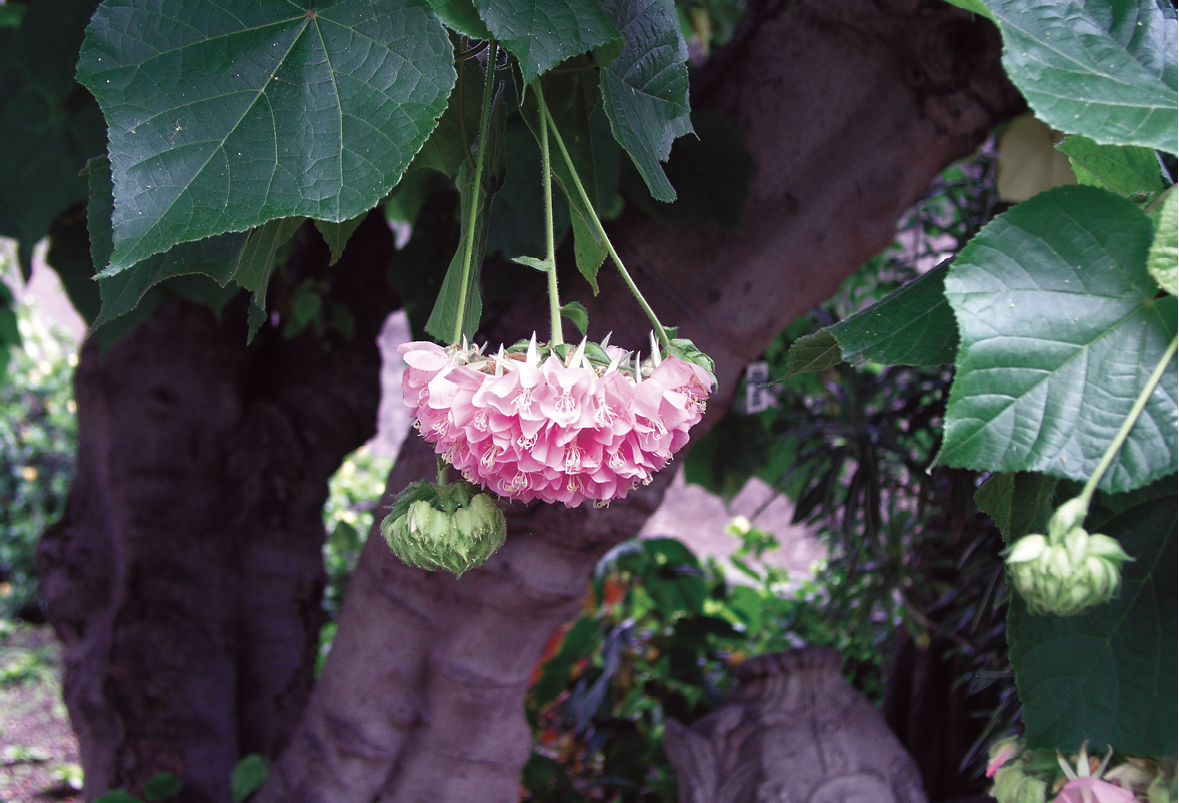
25


In the Gardens
Batwing Coral Tree
Erythrina speciosa
Bloom time
From January to April.
Characteristics
The tree grows up to 5 m (5,5 yd.) tall. The heart-shaped leaves are shed off in win-ter. Blossoms sprout of the bare tree. The conical inflo-rescences are placed at the shoot tips; mostly in little groups on short sprigs. The intense red single blooms have crescent-like ends that rigidly stick out sideways.
Site:
On Madeira you will find the Batwing Coral Tree as an ornamental plant in parks and gardens. It prefers sites in the sunny south-ern part of the island up to an altitude of 300 m (330 yd.). For example there are sev-eral specimens situated in the Parque Santa Catarina (198), Funchal. You can also find the tree growing in Machico and in Ribeira Brava.
Interesting to know:
The Batwing Coral Tree is native to South Brazil. The Abyssinian Coral Tree/Red-Hot Poker Tree (Erythrina abyssinica) is a related species in-digenous to Central and East Africa with brush-shaped flowers. The lobes of the single blossom are narrower and thread-shaped. This species can also be found on Madeira. The seeds of most Coral Tree species are toxic. The seeds of Abyssinian Coral Tree contain a narcotic agent that has a similar effect to curare. It could cause paralysis or even death for human beings.
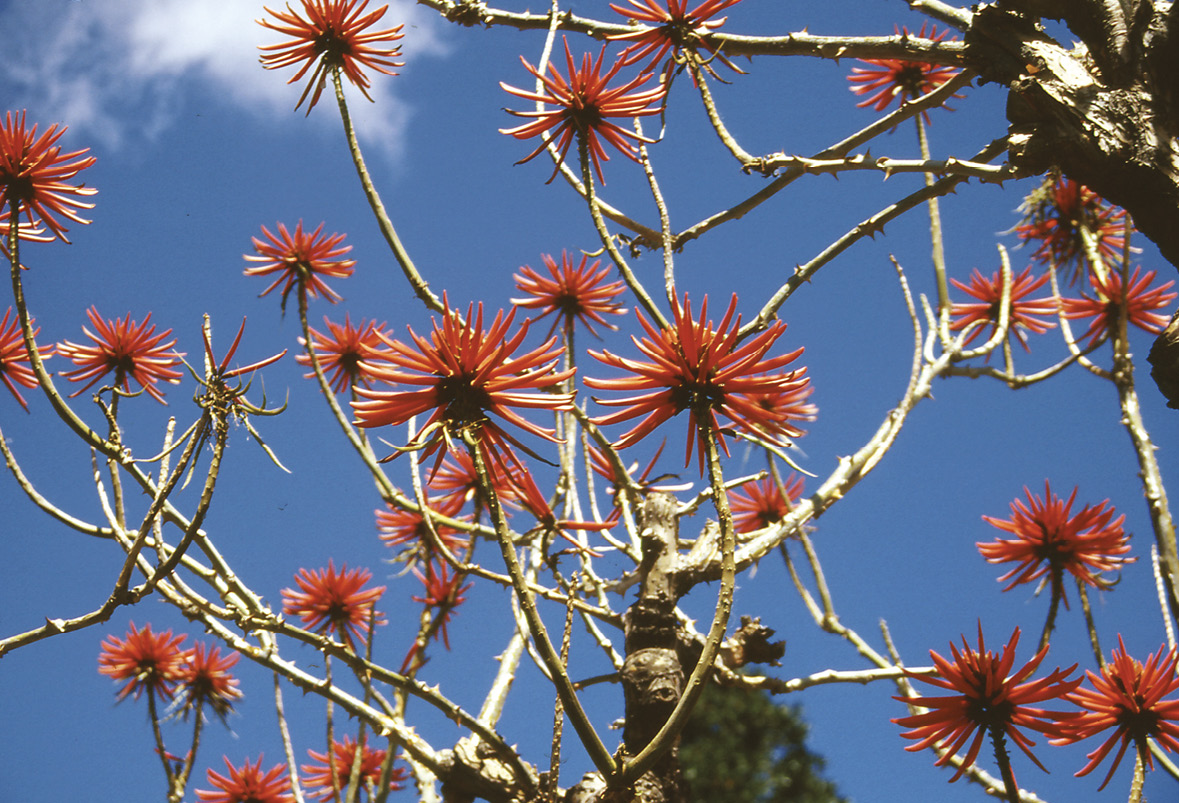
26


In the Gardens
Cock’s Comb Coral Tree
Erythrina crista-galli
Bloom Time
From March to September.
Characteristics
It can grow up to 5 m (6,5 yd.) tall but often stays shrub-shaped. The leathery leaves are roughly pinnate and partly thorny. You can easily distinguish between the Cock’s Comb Coral Tree and other Coral Tree spe-cies represented on Madeira by its blossoms that resem-ble the comb of a rooster.
Site:
In the south of the island you will find spec-imen trees in parks and gardens up to an altitude of 300 m (330 yd.). A remarkably giant specimen grows in front of the church on the main square of Caniço. Occasionally you may also encounter this attractive plant in Funchal.
Interesting to know:
The tree originates from tropical regions in South America (South Brazil, Paraguay, Uru-guay, North Argentina) where it is pollinated by hummingbirds that are drawn by the con-spicuous red blossoms. To attract birds the plant produces particularly much nectar that often drips from the blossoms. Thus the tree is also called “Cry-Baby”. The plant tolerates low frost. Although it uses to freeze back there, it can even be cultivated outdoors in Southern England. Being quite hardy and undemand-ing you may often find it being cultivated in unheated greenhouses of botanical gardens.
27
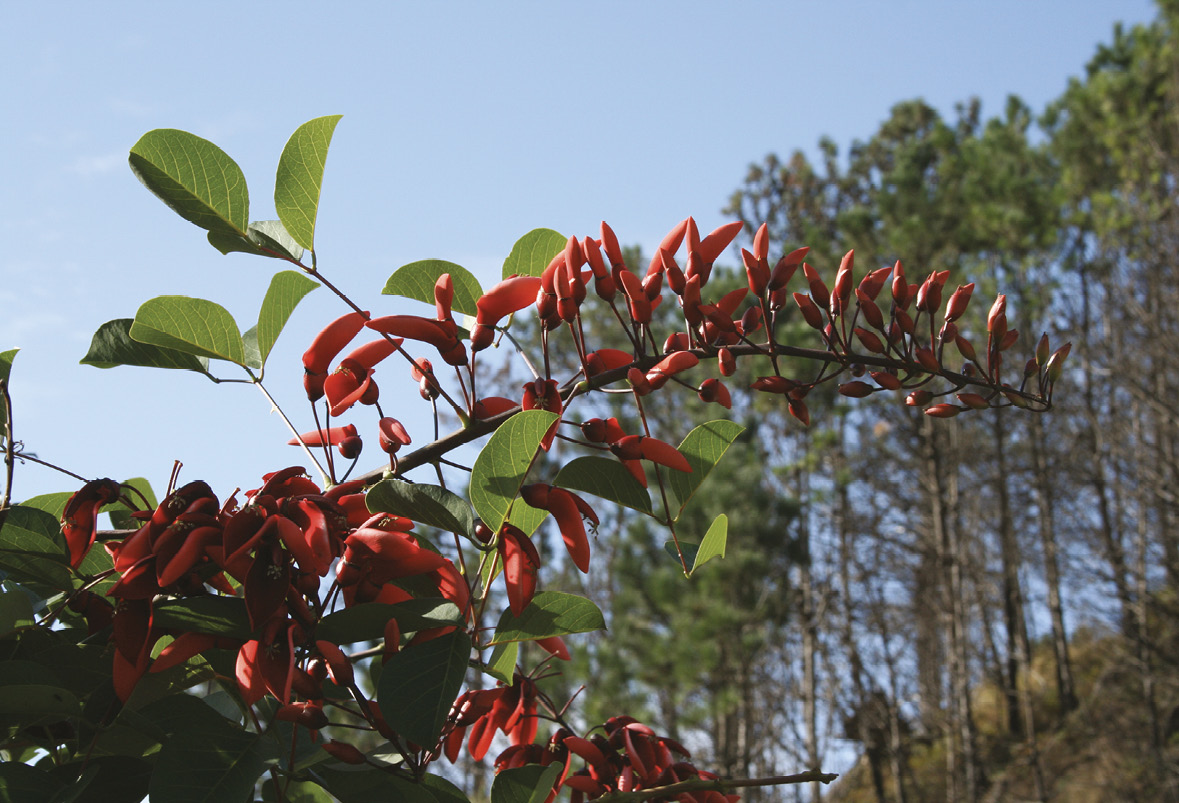


In the Gardens
Judas Tree
Cercis siliquastrum
Bloom time
From March to May.
Characteristics
The little tree grows up to 5 m (5,5 yd.) tall and sheds off its rounded leaves in win-ter. The magenta blossoms remind of those of papilion-aceous plants. They appear before the leaves emerge and are situated in short racemes directly on the twigs (stem-flowering or cauliflo-ry), often lining them entirely.
Site:
On Madeira you will probably not find the Judas Tree very frequently. It prefers quite chilly and foggy sites at an altitude of 300-600 m (330-655 yd.) where it grows in sever-al parks, e.g. in the Palheiro Gardens (191).
Interesting to know:
The tree is native to the bush lands of the eastern Mediterranean regions and the Near East. Its name is derived from “Judaea tree”, denomination that refers to its geographical origin. The legend tells us that Judas Iscariot hung himself on a tree of this species after realizing the consequences he had caused by betraying Christ. The plant’s blossoms are sup-posed to symbolize his blood. Its flat seeds are representing the coins that Judas received by the authorities as the reward for his treason.
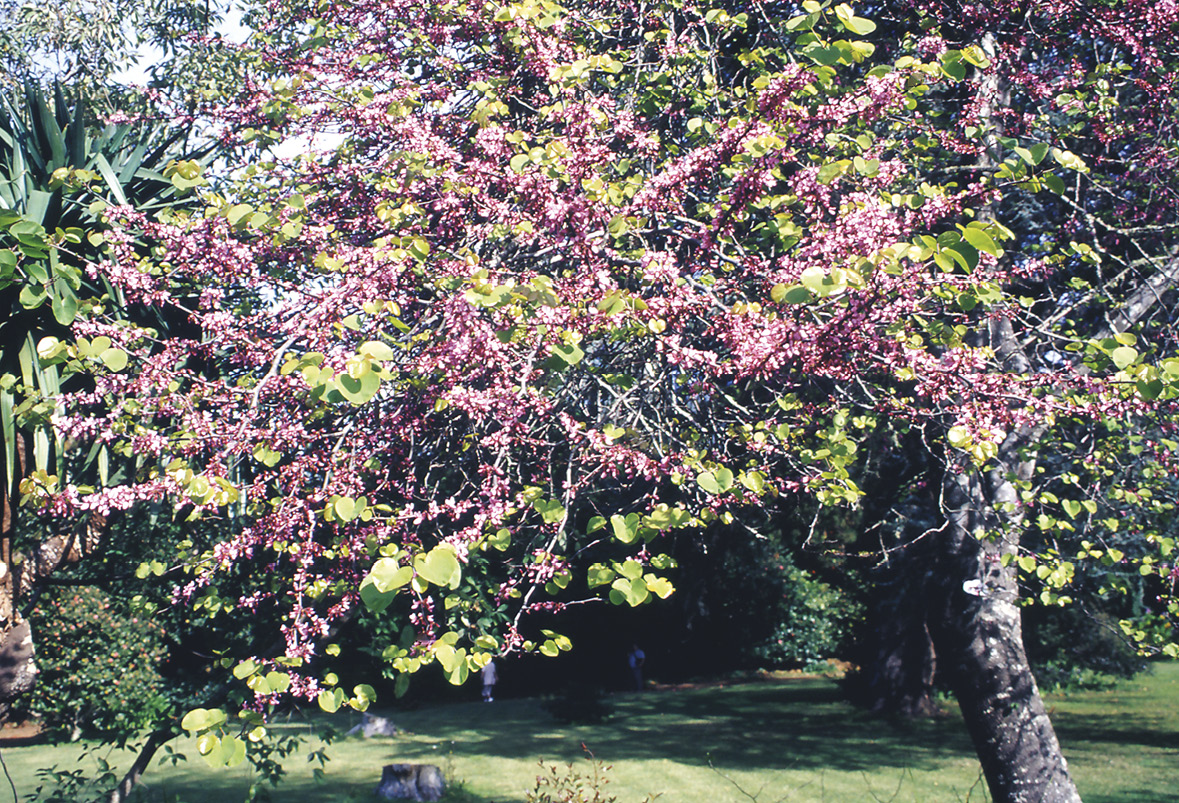
28


In the Gardens



